

Unlocking the genetic and molecular mystery of soft-tissue sarcoma. Scientists at Joslin Diabetes Center in Boston have uncovered important molecular and genetic keys to the development of soft-tissue sarcomas in skeletal muscle, giving researchers and clinicians additional targets to stop the growth of these often deadly tumors.
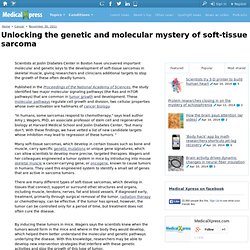
Published in the Proceedings of the National Academy of Sciences, the study identified two major molecular signaling pathways (the Ras and mTOR pathways) that are common in tumor growth and development. These molecular pathways regulate cell growth and division, two cellular properties whose over-activation are hallmarks of cancer biology. "In humans, some sarcomas respond to chemotherapy," says lead author Amy J. Wagers, PhD, an associate professor of stem cell and regenerative biology at Harvard Medical School and Joslin Diabetes Center, "but many don't.
Diabetes drug shows promise in reducing risk of cancer, study suggests. Researchers identify tumor-specific pathway; finding could lead to new cancer-stopping therapies. DALLAS – Nov. 22, 2011 – A research team led by UT Southwestern Medical Center scientists has identified an atypical metabolic pathway unique to some tumors, possibly providing a future target for drugs that could reduce or halt the spread of cancer.
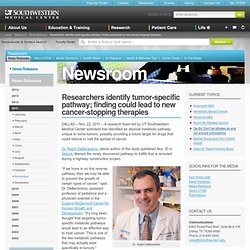
Dr. Ralph DeBerardinis, senior author of the study published Nov. 20 in Nature, likened the newly discovered pathway to traffic that is rerouted during a highway construction project. Dr. Ralph DeBerardinis. Cancer drug cisplatin found to bind like glue in cellular RNA. EUGENE, Ore. -- (Nov. 21, 2011) -- An anti-cancer drug used extensively in chemotherapy binds pervasively to RNA -- up to 20-fold more than it does to DNA, a surprise finding that suggests new targeting approaches might be useful, according to University of Oregon researchers.
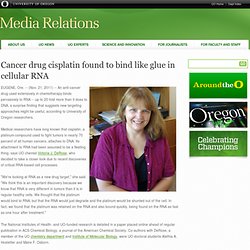
Medical researchers have long known that cisplatin, a platinum compound used to fight tumors in nearly 70 percent of all human cancers, attaches to DNA. Its attachment to RNA had been assumed to be a fleeting thing, says UO chemist Victoria J. DeRose, who decided to take a closer look due to recent discoveries of critical RNA-based cell processes. "We're looking at RNA as a new drug target," she said. "We think this is an important discovery because we know that RNA is very different in tumors than it is in regular healthy cells. Molecules on branched-polymer surfaces can capture rare tumor cells in blood.
New drug combo targets multiple cancers: Sugar molecule primes cancer cells for early death from second compound. Probiotic protects intestine from radiation injury. Public release date: 16-Nov-2011 [ Print | E-mail Share ] [ Close Window ] Contact: Jim Drydenjdryden@wustl.edu 314-286-0110Washington University School of Medicine.
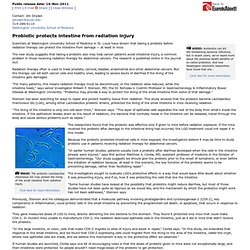
Cancer's sweet tooth may be its weak link. Uncovering a key player in metastasis. About 90 percent of cancer deaths are caused by secondary tumors, known as metastases, which spread from the original tumor site.

To become mobile and break free from the original tumor, cancer cells need help from other cells in their environment. Many cells have been implicated in this process, including immune system cells and cells that form connective tissue. Another collaborator in metastasis is platelets, the blood cells whose normal function is to promote blood clotting. The exact role played by platelets has been unclear, but a new paper from Richard Hynes, the Daniel K.
Ludwig Professor for Cancer Research, and colleagues shows that platelets give off chemical signals that induce tumor cells to become more invasive and plant themselves in new locations. New Way to Target – And Kill – Proliferating Tumors. UC San Diego researchers find surprising role for enzyme in tumor cell division and new drug to combat it Newswise — Researchers at the University of California, San Diego School of Medicine and the UC San Diego Moores Cancer Center have identified a new drug discovery approach enabling the destruction of the most highly proliferative tumors.
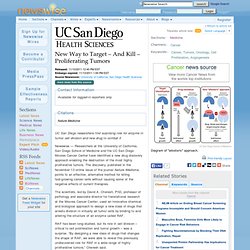
The discovery, published in the November 13 online issue of the journal Nature Medicine, points to an effective, alternative method for killing fast-growing cancer cells without causing some of the negative effects of current therapies. The scientists, led by David A. Biochemical factor important in tumor metastasis unraveled. Molecule serves as a key in some protein interactions. St.
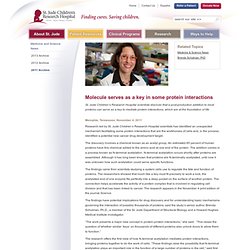
Jude Children’s Research Hospital scientists discover that a post-production addition to most proteins can serve as a key to mediate protein interactions, which are at the foundation of life Memphis, Tennessee, November 4, 2011 Research led by St. Jude Children’s Research Hospital scientists has identified an unexpected mechanism facilitating some protein interactions that are the workhorses of cells and, in the process, identified a potential new cancer drug development target. The discovery involves a chemical known as an acetyl group. The findings came from scientists studying a system cells use to regulate the fate and function of proteins. The findings have potential implications for drug discovery and for understanding basic mechanisms governing the interaction of possibly thousands of proteins, said the study’s senior author, Brenda Schulman, Ph.D., a member of the St.
“The work presents a major new concept in protein-protein interactions,” she said. St. Study identifies an expanded role for PKM2 in helping cancer cells survive. It has long been known that cancer cells use nutrients differently than normal cells.

In recent years, the rapidly reemerging field of cancer metabolism has shed new light on the ways that cancers use glucose to grow and thrive, demonstrating that manipulation of an enzyme called PKM2 is important to this metabolic process. Now a new study led by a scientific team at Beth Israel Deaconess Medical Center (BIDMC) and Harvard Medical School (HMS) has uncovered another key mechanism that cancer cells use as part of their survival strategy -- and once again it seems that they are using PKM2 to their advantage. Reported in the Nov. 3 express online edition of Science, the new findings show that by keeping PKM2 activity at lower-than-normal levels, cancer cells are able to withstand damage caused by oxidative stress and the generation of potentially toxic reactive oxygen species (ROS). But the investigators thought there might be more to the story.
Alternate ending: Living on without telomerase. Scientists of the German Cancer Research Center (Deutsches Krebsforschungszentrum, DKFZ) have discovered an alternative mechanism for the extension of the telomere repeat sequence by DNA repair enzymes.

The ends of the chromosomes, the telomeres, are repetitive DNA sequences that shorten every time a cell divides during the process of duplicating its genome. Once the telomeres become very short the cell stops dividing. Thus, telomeres work like a cellular clock that keeps an eye on the number of cell divisions. And once the cell's time is over it can no longer divide. Cancer-causing H. pylori bug spurs cell death. Researchers have figured out how cancer-causing bug H. pylori, which infects half the world’s population, attacks a cell’s innards, causing it to die by self-destructing.
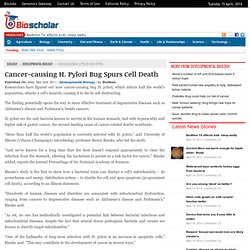
The finding potentially opens the way to more effective treatment of degenerative diseases such as Alzheimer’s disease and Parkinson’s, beside cancers. H. pylori are the only bacteria known to survive in the human stomach, tied with hyperacidity and higher risk of gastric cancer, the second-leading cause of cancer-related deaths worldwide. “More than half the world’s population is currently infected with H. pylori,” said University of Illinois (Urbana-Champaign) microbiology professor Steven Blanke, who led the study.